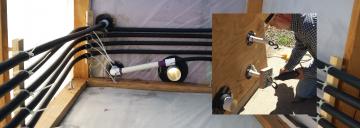Location
If we want to actually solve physical challenges and problems, we’ve got to use science and math, yeah?
When the idea first came to me that it should be possible to design and build a low-cost, temperate-climate, heated, agitated (et al) digester, the first basic design idea that I had was to compress plastic sheets together to make a hermetic (leak-proof) container, insulated on the outside with polystyrene. (I call this a “press-plastic” digester.) Further experiments with materials showed me that polysty could be welded to polysty, and that discovery substantially changed my direction in this project. But even so, I learned a great deal working with my early press-plastic design. One of the first questions that I dove into at some depth was the issue of building a heat exchanger, something that could circulate hot water inside the digester to release its heat and keep things warm. Because, after all, the ‘hot’ in hot water can come from electricity, burning biogas, or solar energy. That is, regardless of what's happening outside the digester, one can have a heat exchange unit inside that will keep things optimally warm...
My initial idea was to use a coil of pipe of some sort, since that seemed simple. But what pipe should I use? How much would I need? What would it cost? I realized that if I was going to get beyond a half-hearted, amateurish, sloppy work-around approach, I needed to dig in and do just a little hard work. What is the relevant math? How do we calculate heat gain and heat loss? I had some idea since I had done research and written chapters for The Complete Biogas Handbook about those subjects, but a lot of what I found out was new. I put almost everything I learned in this small realm in a spreadsheet that I designed for my own use, and… I have posted that here.
The spreadsheet is found here, if you please.
Perhaps I should also expand on the idea that the spreadsheet is my creature, and may not be particularly well suited to a mass audience, because there is not a lot of hand-holding and explanation in the spreadsheet. It was designed and built for me, not only to answer the question of how much heat might be gained from a given surface area of pipe, but as well, to give me indications of which pipe might be more expensive in the task. For example, although copper cannot be used in a digester, it is far, far more efficient at shedding heat than, say, black poly, for equal diameters, lengths and thicknesses of pipe. But copper is expensive and poly is cheap. So (if you could use copper in your digester), how much heat could put into the digester if you were using a dollar's worth of copper pipe vs. a dollar's worth of poly pipe. Right? A dollar would give you a lot less surface area of copper but it would be rather better at shedding heat into the digester. A dollar would give you a lot more surface area of black poly, but it not be as good at heat transfer. So which one will give you the most bang for the buck?
But of course, again, copper is not on our list. This spreadsheet, therefore, compares various diameters of PEX, black poly, and PVC. Enjoy!

